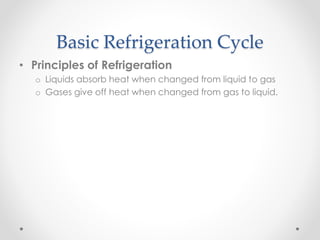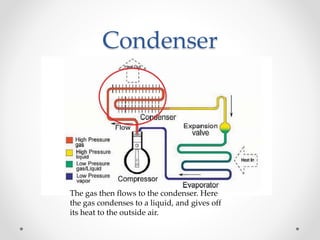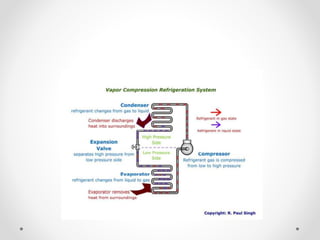Basic refrigeration cycle
- 1. Basic Refrigeration Cycle Presented by Therese Schutte
- 2. Objectives ŌĆó Describe the basic mechanical refrigeration process o Compression o Condensation o Expansion o Evaporation
- 3. Basic Refrigeration Cycle ŌĆó Principles of Refrigeration o Liquids absorb heat when changed from liquid to gas o Gases give off heat when changed from gas to liquid.
- 4. The cycle of cooling
- 5. Compressor The refrigerant comes into the compressor as a low-pressure gas, it is compressed and then moves out of the compressor as a high-pressure gas.
- 6. Condenser The gas then flows to the condenser. Here the gas condenses to a liquid, and gives off its heat to the outside air.
- 7. Expansion Valve/ Metering Device The liquid then moves to the expansion valve under high pressure. This valve restricts the flow of the fluid, and lowers its pressure as it leaves the expansion valve.
- 8. Evaporator The low-pressure liquid then moves to the evaporator, where heat from the inside air is absorbed and changes it from a liquid to a gas.
- 9. Compressor As a hot low-pressure gas, the refrigerant moves to the compressor where the entire cycle is repeated.
Editor's Notes
- #4: For an air conditioning system to operate with economy, the refrigerant must be used repeatedly. For this reason, all air conditioners use the same cycle of compression, condensation, expansion, and evaporation in a closed circuit. The same refrigerant is used to move the heat from one area, to cool this area, and to expel this heat in another area.
- #6: Pumps Vapor to condensor
- #7: Forces Vapor to reject heat and turns back into liquid to be used
- #8: Tex ŌĆō Meters liquid back to vapor
- #9: Absorbs heat from refrigerated space and forces liquid to become vapor










